 When I interviewed Laura Hoptman Sept. 9 she told me she was surprised at how much sculpture there was in the International.
When I interviewed Laura Hoptman Sept. 9 she told me she was surprised at how much sculpture there was in the International.
In particular, she was taken with the number of sculptural objects as opposed to sculptural installations coming in. (top is detail of Maurizio Cattelan‘s object, “Now,” made of wax, human hair, resin and clothes)

It’s a lesson on how far sculpture has flexed over the last couple of decades that sculptural objects should be a surprise in a big, all-encompassing show like this.
(image is installation shot of Kathy Butterly‘s jewel-like vessels, made of porcelain, earthenware and glaze)
The Mother of all object making?
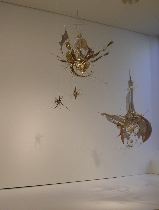
Of course Lee Bontecou, who has 27 works in the exhibit, makes objects and even makes paintings that are sculptural objects. Bontecou’s 3-D works, which dangle like an intergalactic armada with tiny masts, flags, sails and cyclopsian eyeballs, are most wondrous to behold. Jewels in the air, they are infinitely evocative and seductive. (image is installation shot of Bontecou’s untitled works, made from welded steel, porcelain, wire mesh, silk and wire)
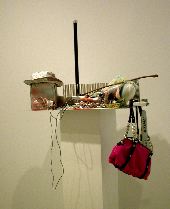
Isa Genzken, too, makes jewel-like objects, although her pedestal-mounted mini-worlds might be considered installations since they encompass a multitude of objects situated in a real, although, tiny space on a pedestal. But I’ll call them objects just the same. (image is a Genzken environment from the Empire/Vampire series)
Butterly, Bontecou, Genzken and even Cattelan are making love objects. You can feel the artist’s hard work, sweat and happiness in their making. It’s the happiness of messing around in the 3-D world, something that will never go out of style as long as there are people on earth — and clay and Home Depot.
Darkling objects
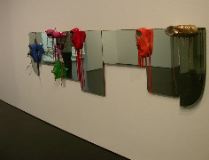
Jim Lambie and Francis Alys make objects with a darker edge. Lambie’s objects, like “Bleached Highlights” (shown) look cobbled together from second-hand materials (mirrors, sneakers, paint) and while the bright colors and slip-sloppy construction connote happy, playful, childlike, there’s a forlorn quality and a message about a world too cheerful for its own good.
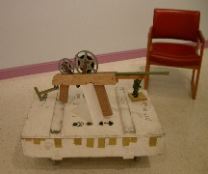
Lambie, by the way, actually made an installation of sorts. His objects sit on a floor covering, a wall-to-wall carpet of sorts, he made out of electrical tape. It’s a black rug that’s reminiscent of a Frank Stella black painting.
Alys, who paints like a charm and is madly trying to make sense of things like life, death, suicide bombings, the uprisings in Chiapas (he’s lived in Mexico for 20 years) has fashioned a couple of machine guns from wood and movie projector reels that are crude but effective communicators about violence, broadcasting and exploitation. (shown)
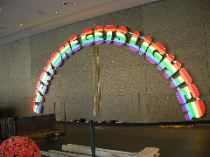
Ugo Rondinone, who shows up with a video installation that was nice but seemed familiar (it reminded both Libby and me of the Doug Aitken video installation at the Fabric Workshop a couple years back) also made a sculptural object. A luminous Sesame St. rainbow whose message “Everyone gets lighter” is so forlorn it would fail the tryout for a spot on PBS. By the way, Libby and I saw the installers struggling with this, seemingly trade show simple piece the night before the show opened. In fact, the morning of the press preview it still was not functioning. Only when we exited the museum at around 3 p.m. was the work up and fully operational. (Some installations are probably simpler.)
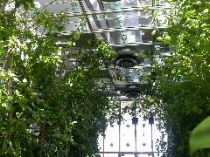 Where there’s a rainbow, can a greenhouse be far behind? Carsten Holler‘s “Solandra Greenhouse” (shown) is what it sounds like — a glass house loaded with plants. The piece, by the Belgian-born artist who is also a biologist is sited in a sunny hallway and replete with Solandra maxima vines that throw off “pheromones capable of inducing amorous feelings.” There are also green flashing strobe lights and grow lights and Holler who lives Sweden is obsessed with human emotion and human interaction. As the plants grow and emit more pheromones it might be possible to get a whiff and fall in love with someone or something with you in the space. As it was when I walked through it smelled a whole lot better than Frank’s Nursery and I kind of liked it.
Where there’s a rainbow, can a greenhouse be far behind? Carsten Holler‘s “Solandra Greenhouse” (shown) is what it sounds like — a glass house loaded with plants. The piece, by the Belgian-born artist who is also a biologist is sited in a sunny hallway and replete with Solandra maxima vines that throw off “pheromones capable of inducing amorous feelings.” There are also green flashing strobe lights and grow lights and Holler who lives Sweden is obsessed with human emotion and human interaction. As the plants grow and emit more pheromones it might be possible to get a whiff and fall in love with someone or something with you in the space. As it was when I walked through it smelled a whole lot better than Frank’s Nursery and I kind of liked it.
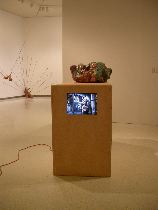
Libby and I both scratched our heads at Rachel Harrison‘s sculptures. Harrison, who also has a suite of photographs situated on the walls surrounding her 3-D works, would have been better served if the photos had been separated from the 3-D works. Their close placement together caused more confusion than necessary as I, for one, kept trying to piece together a narrative of sorts that linked the two.
Because the photos deal with belief systems (they show religious devotees touching the window of a house where an apparition of the Virgin Mary had appeared I read belief system into the sculptures as well. Whether or not that’s right, I couldn’t avoid the interpretation due to the photos. The sculptures, which involve colorful blobs sitting atop a house or a set of steps, or in one case a box atop a tower made of styrofoam, seemed to refer to belief systems, the blobs being the belief, the house or steps the system. (shown is “Marathon Station” which shows a man placing money in a soda machine and waiting for the can to descend…belief system at work?)
Off the Charts
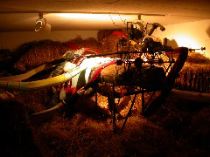
I left the most disturbing piece in the show for the last, John Bock‘s sculptural environment used in his filmed performance “Meechfever” which plays somewhere in the big museum. (I’m sorry we didn’t get to see it.) Like Paul McCarthy, Bock’s work registers high on the nasty scale. The work has an entryway with carpets and a glass vitrine holding Bertolt Brecht’s fingernails. It’s downhill from there on in. You descend into a world of mad, inwardness that’s like the sanctum sanctorum of a scientist who can’t deal with the external world any more and is living in lies, dreams, and memories, constructing a monstrous thing in the straw-filled attic. (image–somebody said it was an airplane; Libby said it was Frankenstein; I agree with Libby — it’s mad science)
I interpreted this difficult, Halloweenish piece as a condemnation of isolationism in all its personal, national and international meanings. It was hard to look at but I admired its passion.
In sum, objects, objects, objects are singing in this show. And installations like Holler’s and Bock’s are the exception, not the norm. In all cases, the works had much to say for themselves and I was happy to be all eyes and ears.









